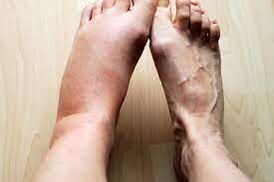Veteran Heart Surgeon Explains When Leg Swelling Signals Real Trouble

New Delhi | Nov 15, 2025 A seasoned cardiovascular expert with more than 25 years in the field has offered clarity on a question many people quietly worry about: when does swelling in the legs become a medical red flag? Leg swelling — medically known as edema — is fairly common and often harmless. But as heart surgeon Dr Jeremy London explained on November 14, there are circumstances where it reflects something far more serious. Swelling happens when fluid escapes from blood vessels and accumulates in the tissues of the lower limbs. This can make legs feel heavy, appear puffy, and become uncomfortable to move. While everyday causes like long hours of sitting or minor strain may trigger it, Dr London stressed that certain warning signs require prompt medical attention. He highlighted several conditions that can sit behind persistent or unusual swelling. Chronic venous insufficiency, where the veins struggle to return blood to the heart, is a major one. When veins weaken, blood collects in the legs, leading to swelling. Problems with vital organs — the heart, kidneys, or liver — can also allow fluid to build up in the body and settle in the lower extremities. Medications can play a role too. Drugs used for hypertension, hormone therapy, or pain relief may cause fluid retention. Another potential cause is lymphedema, which develops when the lymphatic system — the body’s natural drainage network — becomes blocked or overwhelmed. Movement, Dr London noted, is one of the simplest and most effective responses. Walking activates the leg muscles, helping push blood upward toward the heart. Elevating the legs above heart level and using compression stockings can also reduce fluid buildup. But the surgeon cautioned that certain symptoms should never be ignored. If swelling appears suddenly, affects only one leg, or comes with pain, chest tightness, or difficulty breathing, it may signal a blood clot. In such cases, immediate evaluation is essential. While most swelling isn’t dangerous on its own, Dr London emphasised the importance of paying attention to early signals. “Your body is communicating with you,” he advised. “Responding early can keep minor issues from turning into major problems.” Veteran Heart Surgeon Explains When Leg Swelling Signals Real Trouble Leg swelling is common, but not always as innocent as it looks. A leading heart surgeon with decades of experience warns that while puffiness in your legs or ankles often comes from long hours of sitting or routine strain, certain signs shouldn’t be brushed aside. Swelling happens when excess fluid leaks from blood vessels and collects in the tissues, making your legs feel heavy or tight. But if your veins aren’t pushing blood back to the heart properly, the fluid can pool and create ongoing swelling. Problems with the heart, kidneys, or liver may also cause fluid to back up and settle in the lower body. Even common medications for blood pressure, hormones, or pain can add to the issue. And in some cases, the lymphatic system struggles to drain fluid, leading to lymphedema. The surgeon stresses that movement is essential — walking helps pump blood upward, and elevating your legs or using compression stockings can offer relief. But if swelling appears suddenly, affects one leg, or comes with pain or breathing discomfort, it needs urgent attention. Listening to early signals can prevent bigger trouble later.




